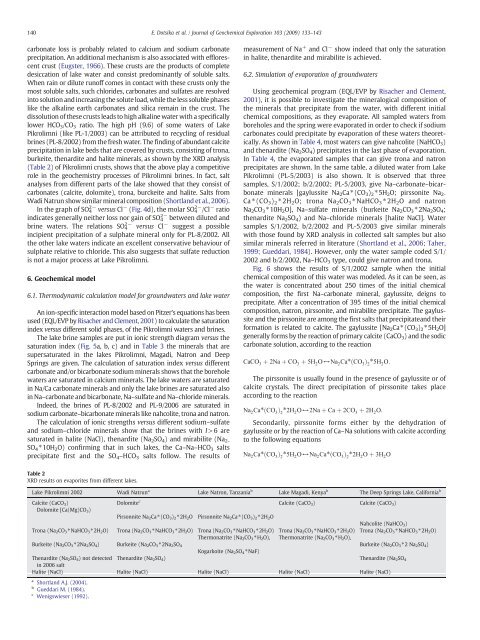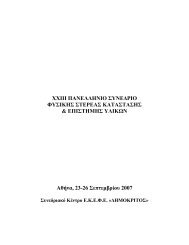A natron source at Pikrolimni Lake in Greece? Geochemical evidence
A natron source at Pikrolimni Lake in Greece? Geochemical evidence
A natron source at Pikrolimni Lake in Greece? Geochemical evidence
You also want an ePaper? Increase the reach of your titles
YUMPU automatically turns print PDFs into web optimized ePapers that Google loves.
140 E. Dotsika et al. / Journal of <strong>Geochemical</strong> Explor<strong>at</strong>ion 103 (2009) 133–143<br />
carbon<strong>at</strong>e loss is probably rel<strong>at</strong>ed to calcium and sodium carbon<strong>at</strong>e<br />
precipit<strong>at</strong>ion. An additional mechanism is also associ<strong>at</strong>ed with efflorescent<br />
crust (Eugster, 1966). These crusts are the products of complete<br />
desicc<strong>at</strong>ion of lake w<strong>at</strong>er and consist predom<strong>in</strong>antly of soluble salts.<br />
When ra<strong>in</strong> or dilute runoff comes <strong>in</strong> contact with these crusts only the<br />
most soluble salts, such chlorides, carbon<strong>at</strong>es and sulf<strong>at</strong>es are resolved<br />
<strong>in</strong>to solution and <strong>in</strong>creas<strong>in</strong>g the solute load, while the less soluble phases<br />
like the alkal<strong>in</strong>e earth carbon<strong>at</strong>es and silica rema<strong>in</strong> <strong>in</strong> the crust. The<br />
dissolution of these crusts leads to high alkal<strong>in</strong>e w<strong>at</strong>er with a specifically<br />
lower HCO 3 /CO 3 r<strong>at</strong>io. The high pH (9.6) of some w<strong>at</strong>ers of <strong>Lake</strong><br />
<strong>Pikrolimni</strong> (like PL-1/2003) can be <strong>at</strong>tributed to recycl<strong>in</strong>g of residual<br />
br<strong>in</strong>es (PL-8/2002) from the fresh w<strong>at</strong>er. The f<strong>in</strong>d<strong>in</strong>g of abundant calcite<br />
precipit<strong>at</strong>ion <strong>in</strong> lake beds th<strong>at</strong> are covered by crusts, consist<strong>in</strong>g of trona,<br />
burkeite, thenardite and halite m<strong>in</strong>erals, as shown by the XRD analysis<br />
(Table 2) of <strong>Pikrolimni</strong> crusts, shows th<strong>at</strong> the above play a competitive<br />
role <strong>in</strong> the geochemistry processes of <strong>Pikrolimni</strong> br<strong>in</strong>es. In fact, salt<br />
analyses from different parts of the lake showed th<strong>at</strong> they consist of<br />
carbon<strong>at</strong>es (calcite, dolomite), trona, burckeite and halite. Salts from<br />
Wadi N<strong>at</strong>run show similar m<strong>in</strong>eral composition (Shortland et al., 2006).<br />
In the graph of SO 4 2− versus Cl − (Fig. 4d), the molar SO 4 2− /Cl − r<strong>at</strong>io<br />
<strong>in</strong>dic<strong>at</strong>es generally neither loss nor ga<strong>in</strong> of SO 4 2− between diluted and<br />
br<strong>in</strong>e w<strong>at</strong>ers. The rel<strong>at</strong>ions SO 4 2− versus Cl − suggest a possible<br />
<strong>in</strong>cipient precipit<strong>at</strong>ion of a sulph<strong>at</strong>e m<strong>in</strong>eral only for PL-8/2002. All<br />
the other lake w<strong>at</strong>ers <strong>in</strong>dic<strong>at</strong>e an excellent conserv<strong>at</strong>ive behaviour of<br />
sulph<strong>at</strong>e rel<strong>at</strong>ive to chloride. This also suggests th<strong>at</strong> sulf<strong>at</strong>e reduction<br />
is not a major process <strong>at</strong> <strong>Lake</strong> <strong>Pikrolimni</strong>.<br />
6. <strong>Geochemical</strong> model<br />
6.1. Thermodynamic calcul<strong>at</strong>ion model for groundw<strong>at</strong>ers and lake w<strong>at</strong>er<br />
An ion-specific <strong>in</strong>teraction model based on Pitzer's equ<strong>at</strong>ions has been<br />
used (EQL/EVP by Risacher and Clement, 2001) to calcul<strong>at</strong>e the s<strong>at</strong>ur<strong>at</strong>ion<br />
<strong>in</strong>dex versus different solid phases, of the <strong>Pikrolimni</strong> w<strong>at</strong>ers and br<strong>in</strong>es.<br />
The lake br<strong>in</strong>e samples are put <strong>in</strong> ionic strength diagram versus the<br />
s<strong>at</strong>ur<strong>at</strong>ion <strong>in</strong>dex (Fig. 5a, b, c) and <strong>in</strong> Table 3 the m<strong>in</strong>erals th<strong>at</strong> are<br />
supers<strong>at</strong>ur<strong>at</strong>ed <strong>in</strong> the lakes <strong>Pikrolimni</strong>, Magadi, N<strong>at</strong>ron and Deep<br />
Spr<strong>in</strong>gs are given. The calcul<strong>at</strong>ion of s<strong>at</strong>ur<strong>at</strong>ion <strong>in</strong>dex versus different<br />
carbon<strong>at</strong>e and/or bicarbon<strong>at</strong>e sodium m<strong>in</strong>erals shows th<strong>at</strong> the borehole<br />
w<strong>at</strong>ers are s<strong>at</strong>ur<strong>at</strong>ed <strong>in</strong> calcium m<strong>in</strong>erals. The lake w<strong>at</strong>ers are s<strong>at</strong>ur<strong>at</strong>ed<br />
<strong>in</strong> Na/Ca carbon<strong>at</strong>e m<strong>in</strong>erals and only the lake br<strong>in</strong>es are s<strong>at</strong>ur<strong>at</strong>ed also<br />
<strong>in</strong> Na–carbon<strong>at</strong>e and bicarbon<strong>at</strong>e, Na–sulf<strong>at</strong>e and Na–chloride m<strong>in</strong>erals.<br />
Indeed, the br<strong>in</strong>es of PL-8/2002 and PL-9/2006 are s<strong>at</strong>ur<strong>at</strong>ed <strong>in</strong><br />
sodium carbon<strong>at</strong>e–bicarbon<strong>at</strong>e m<strong>in</strong>erals like nahcolite, trona and <strong>n<strong>at</strong>ron</strong>.<br />
Τhe calcul<strong>at</strong>ion of ionic strengths versus different sodium–sulf<strong>at</strong>e<br />
and sodium–chloride m<strong>in</strong>erals show th<strong>at</strong> the br<strong>in</strong>es with Ι>6 are<br />
s<strong>at</strong>ur<strong>at</strong>ed <strong>in</strong> halite (NaCl), thenardite (Na 2 SO 4 ) and mirabilite (Na 2-<br />
SO 4 ⁎10H 2 O) confirm<strong>in</strong>g th<strong>at</strong> <strong>in</strong> such lakes, the Ca–Na–HCO 3 salts<br />
precipit<strong>at</strong>e first and the SO 4 –HCO 3 salts follow. The results of<br />
measurement of Na + and Cl − show <strong>in</strong>deed th<strong>at</strong> only the s<strong>at</strong>ur<strong>at</strong>ion<br />
<strong>in</strong> halite, thenardite and mirabilite is achieved.<br />
6.2. Simul<strong>at</strong>ion of evapor<strong>at</strong>ion of groundw<strong>at</strong>ers<br />
Us<strong>in</strong>g geochemical program (EQL/EVP by Risacher and Clement,<br />
2001), it is possible to <strong>in</strong>vestig<strong>at</strong>e the m<strong>in</strong>eralogical composition of<br />
the m<strong>in</strong>erals th<strong>at</strong> precipit<strong>at</strong>e from the w<strong>at</strong>er, with different <strong>in</strong>itial<br />
chemical compositions, as they evapor<strong>at</strong>e. All sampled w<strong>at</strong>ers from<br />
boreholes and the spr<strong>in</strong>g were evapor<strong>at</strong>ed <strong>in</strong> order to check if sodium<br />
carbon<strong>at</strong>es could precipit<strong>at</strong>e by evapor<strong>at</strong>ion of these w<strong>at</strong>ers theoretically.<br />
As shown <strong>in</strong> Table 4, most w<strong>at</strong>ers can give nahcolite (NaHCO 3 )<br />
and thenardite (Na 2 SO 4 ) precipit<strong>at</strong>es <strong>in</strong> the last phase of evapor<strong>at</strong>ion.<br />
Ιn Table 4, the evapor<strong>at</strong>ed samples th<strong>at</strong> can give trona and <strong>n<strong>at</strong>ron</strong><br />
precipit<strong>at</strong>es are shown. In the same table, a diluted w<strong>at</strong>er from <strong>Lake</strong><br />
<strong>Pikrolimni</strong> (PL-5/2003) is also shown. It is observed th<strong>at</strong> three<br />
samples, S/1/2002; b/2/2002; PL-5/2003, give Na–carbon<strong>at</strong>e–bicarbon<strong>at</strong>e<br />
m<strong>in</strong>erals [gaylussite Na 2 Ca⁎(CO 3 ) 2 ⁎5H 2 O; pirssonite Na 2-<br />
Ca⁎ (CO 3 ) 2 ⁎ 2H 2 O; trona Na 2 CO 3 ⁎ NaHCO 3 ⁎ 2H 2 O and <strong>n<strong>at</strong>ron</strong><br />
Na 2 CO 3 ⁎10H 2 O], Na–sulf<strong>at</strong>e m<strong>in</strong>erals (burkeite Na 2 CO 3 ⁎2Na 2 SO 4 ;<br />
thenardite Na 2 SO 4 ) and Na–chloride m<strong>in</strong>erals [halite NaCl]. W<strong>at</strong>er<br />
samples S/1/2002, b/2/2002 and PL-5/2003 give similar m<strong>in</strong>erals<br />
with those found by XRD analysis <strong>in</strong> collected salt samples but also<br />
similar m<strong>in</strong>erals referred <strong>in</strong> liter<strong>at</strong>ure (Shortland et al., 2006; Taher,<br />
1999; Gueddari, 1984). However, only the w<strong>at</strong>er sample coded S/1/<br />
2002 and b/2/2002, Na–ΗCO 3 type, could give <strong>n<strong>at</strong>ron</strong> and trona.<br />
Fig. 6 shows the results of S/1/2002 sample when the <strong>in</strong>itial<br />
chemical composition of this w<strong>at</strong>er was modeled. As it can be seen, as<br />
the w<strong>at</strong>er is concentr<strong>at</strong>ed about 250 times of the <strong>in</strong>itial chemical<br />
composition, the first Na–carbon<strong>at</strong>e m<strong>in</strong>eral, gaylussite, deigns to<br />
precipit<strong>at</strong>e. After a concentr<strong>at</strong>ion of 395 times of the <strong>in</strong>itial chemical<br />
composition, <strong>n<strong>at</strong>ron</strong>, pirssonite, and mirabilite precipit<strong>at</strong>e. The gaylussite<br />
and the pirssonite are among the first salts th<strong>at</strong> precipit<strong>at</strong>eand their<br />
form<strong>at</strong>ion is rel<strong>at</strong>ed to calcite. The gaylussite [Na 2 Ca⁎(CO 3 ) 2 ⁎5H 2 O]<br />
generally forms by the reaction of primary calcite (CaCO 3 )andthesodic<br />
carbon<strong>at</strong>e solution, accord<strong>in</strong>g to the reaction<br />
CaCO 3 þ 2Na þ CO 3 þ 5H 2 O↔Na 2 Ca⁎ðCO 3 Þ 2<br />
⁎5H 2 O:<br />
The pirssonite is usually found <strong>in</strong> the presence of gaylussite or of<br />
calcite crystals. The direct precipit<strong>at</strong>ion of pirssonite takes place<br />
accord<strong>in</strong>g to the reaction<br />
Na 2 Ca⁎ðCO 3 Þ 2<br />
⁎2H 2 O↔2Na þ Ca þ 2CO 3 þ 2H 2 O:<br />
Secondarily, pirssonite forms either by the dehydr<strong>at</strong>ion of<br />
gaylussite or by the reaction of Ca–Na solutions with calcite accord<strong>in</strong>g<br />
to the follow<strong>in</strong>g equ<strong>at</strong>ions<br />
Na 2 Ca⁎ðCO 3 Þ 2<br />
⁎5H 2 O↔Na 2 Ca⁎ðCO 3 Þ 2<br />
⁎2H 2 O þ 3H 2 O<br />
Table 2<br />
XRD results on evaporites from different lakes.<br />
<strong>Lake</strong> <strong>Pikrolimni</strong> 2002 Wadi N<strong>at</strong>run a <strong>Lake</strong> N<strong>at</strong>ron, Tanzania b <strong>Lake</strong> Magadi, Kenya b The Deep Spr<strong>in</strong>gs <strong>Lake</strong>, California b<br />
Calcite (CaCO 3 )<br />
Dolomite c Calcite (CaCO 3 ) Calcite (CaCO 3 )<br />
Dolomite [Ca(Mg)CO 3 )<br />
Pirsonnite Na 2 Ca⁎(CO 3 ) 2 ⁎2H 2 O Pirsonnite Na 2 Ca⁎(CO 3 ) 2 ⁎2H 2 O<br />
Nahcolite (NaHCO 3 )<br />
Trona (Na 2 CO 3 ⁎NaHCO 3 ⁎2H 2 O) Trona (Na 2 CO 3 ⁎NaHCO 3 ⁎2H 2 O) Trona (Na 2 CO 3 ⁎NaHCO 3 ⁎2H 2 O) Trona (Na 2 CO 3 ⁎NaHCO 3 ⁎2H 2 O) Trona (Na 2 CO 3 ⁎NaHCO 3 ⁎2H 2 O)<br />
Thermon<strong>at</strong>rite (Na 2 CO 3 ⁎H 2 O), Thermon<strong>at</strong>rite (Na 2 CO 3 ⁎H 2 O),<br />
Burkeite (Na 2 CO 3 ⁎2Na 2 SO 4 ) Burkeite (Na 2 CO 3 ⁎2Na 2 SO 4 Burkeite (Na 2 CO 3 ⁎2Na 2 SO 4 )<br />
Kogarkoite (Na 2 SO 4 ⁎NaF)<br />
Thenardite (Na 2 SO 4 ) not detected Thenardite (Na 2 SO 4 ) Thenardite (Na 2 SO 4<br />
<strong>in</strong> 2006 salt<br />
Halite (NaCl) Halite (NaCl) Halite (NaCl) Halite (NaCl) Halite (NaCl)<br />
a Shortland A.J. (2004).<br />
b Gueddari M. (1984).<br />
c Wenigswieser (1992).
















